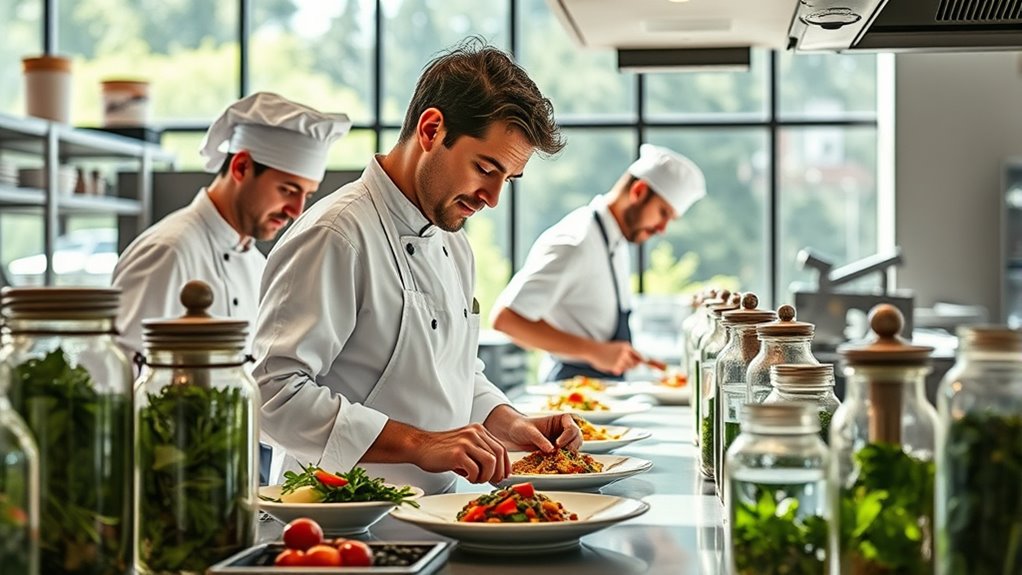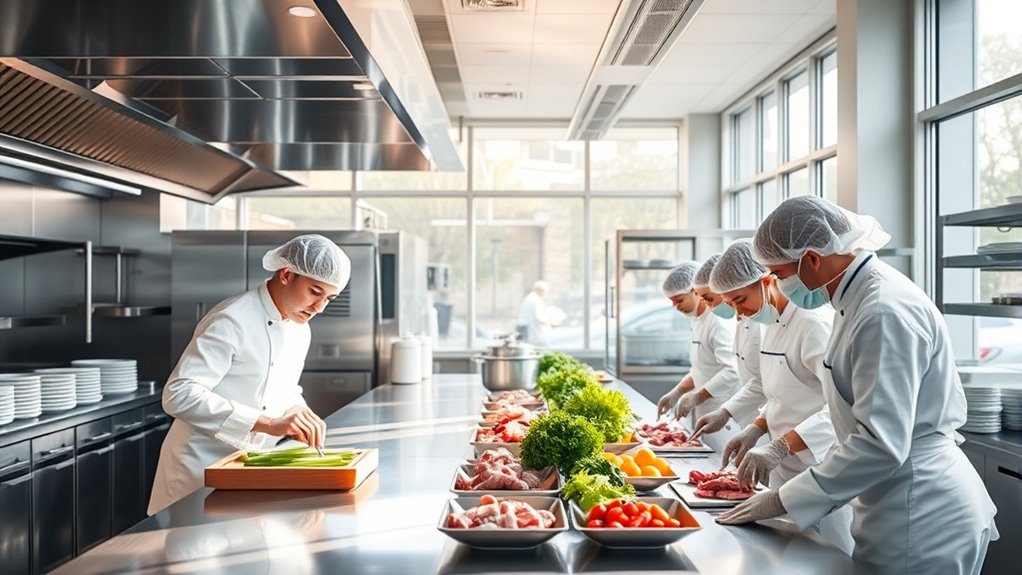Building trust with your customers comes from openly sharing your kitchen practices and food safety measures. Show your commitment by displaying certifications, explaining hygiene routines, and sourcing ingredients responsibly. Invite guests to observe sanitation or view prep videos online to boost confidence. Transparency signals respect and builds long-term loyalty. If you want to discover more ways to enhance trust through honesty and openness, explore how industry standards and digital engagement can strengthen your reputation even further.
Key Takeaways
- Display certifications and safety protocols visibly to demonstrate compliance and reassure guests.
- Invite customers to observe sanitation routines and food prep processes for transparency.
- Share ingredient sourcing stories, emphasizing local, organic, and responsible suppliers to build trust.
- Use digital platforms to communicate safety measures and sourcing details openly with customers.
- Follow industry standards and regulations, showcasing commitment to high safety and quality benchmarks.

Have you ever wondered how restaurants earn your trust? It all comes down to transparency and consistency in their kitchen practices. When you step into a restaurant, you want to feel confident that the food you’re about to enjoy is safe, fresh, and responsibly prepared. That’s where transparent kitchen practices make a real difference. By openly sharing their approach to food safety and ingredient sourcing, restaurants build a solid foundation of trust with their guests.
Food safety is a top priority, and when restaurants are transparent about their procedures, it reassures you that your health is taken seriously. They might display certifications or actively explain how they maintain proper hygiene standards, store ingredients at the correct temperatures, and prevent cross-contamination. Some establishments even invite you to peek behind the scenes to see their sanitation routines in action. This openness shows that they’re committed to safeguarding your well-being, not just claiming it. When you see visible adherence to safety protocols, it makes you more comfortable ordering that dish, knowing your meal is prepared in a safe environment.
Ingredient sourcing is another key aspect that influences your trust. When restaurants openly discuss where their ingredients come from, you gain insight into their commitment to quality and ethical practices. For example, a restaurant might highlight their partnerships with local farmers or their efforts to select organic produce. Such transparency shows you that they prioritize fresh, responsibly sourced ingredients over cheaper, lower-quality alternatives. It also demonstrates their dedication to sustainability and supporting local communities. When you’re informed about ingredient sourcing, you’re more likely to appreciate the care and effort that go into each dish, making your dining experience more satisfying and meaningful.
Many restaurants now incorporate digital displays or menus that detail ingredient origins and safety measures. Others host open kitchen events or share videos of their food prep process on social media. These efforts aren’t just marketing tricks; they’re genuine attempts to connect with you through honesty. When a restaurant openly talks about their practices, it signals respect for their customers and a desire to build long-term relationships. You’re less likely to feel uncertain or skeptical when you know they’re committed to transparency in both food safety and ingredient sourcing.
Additionally, referencing reputable sources or industry standards can further reinforce a restaurant’s credibility. For instance, adhering to guidelines from organizations like food safety authorities demonstrates their commitment to maintaining high safety standards. When a restaurant openly talks about their practices, it signals respect for their customers and a desire to build long-term relationships. You’re less likely to feel uncertain or skeptical when you know they’re committed to transparency in both food safety and ingredient sourcing.
Ultimately, transparent kitchen practices are about creating a relationship of trust. When you see honesty in how a restaurant handles safety protocols and where their ingredients come from, it enhances your confidence. You become more than just a customer—you become a partner in the dining experience, knowing that your health and enjoyment are prioritized every step of the way. That’s how restaurants earn your trust and keep you coming back for more.
Frequently Asked Questions
How Do I Train Staff on Transparency Protocols Effectively?
You train staff on transparency protocols by emphasizing staff accountability and using visual communication tools. Start with clear, visual signage and demonstrations to show transparency practices. Encourage open conversations where staff can ask questions and share concerns. Regularly review protocols, provide feedback, and recognize accountability. This hands-on approach helps your team understand the importance of transparency, fostering trust with customers and ensuring everyone adheres to established standards effectively.
What Technology Can Enhance Kitchen Transparency?
You can enhance kitchen transparency with technology like digital screens showing real-time ingredient sourcing details and waste management data. Using inventory management software, you track ingredient origins, ensuring quality and ethical sourcing. Waste tracking apps help monitor and reduce waste, boosting trust. Implementing these tools makes your practices visible to staff and customers, fostering confidence in your transparency efforts and reinforcing your commitment to honest kitchen operations.
How Do I Handle Customer Concerns About Kitchen Practices?
You should address customer concerns directly by sharing your commitment to ingredient sourcing and allergen management. For instance, 85% of diners appreciate transparency about food origins. Reassure them by explaining how your kitchen maintains strict allergen protocols and sources ingredients responsibly. Listen patiently, answer questions honestly, and offer to show them your practices. This builds trust and demonstrates your dedication to their safety and satisfaction.
What Are Common Challenges in Maintaining Transparency?
You might face challenges like ensuring consistent ingredient sourcing and maintaining high sanitation procedures. Customers often worry about where ingredients come from and if your kitchen follows strict hygiene standards. To overcome this, stay transparent by sharing sourcing details and sanitation practices openly. Regularly update your team and involve them in transparency efforts, making it easier to build trust and handle concerns proactively.
How Can Transparency Improve Overall Food Safety Standards?
Transparency enhances food safety standards by openly sharing ingredient sourcing and waste management practices. When you communicate where ingredients come from, customers trust your quality and safety measures. Proper waste management, shown transparently, reduces contamination risks and demonstrates your commitment to hygiene. By being honest about these practices, you foster trust, encourage accountability, and ensure your kitchen meets high safety standards, ultimately protecting your customers and building a strong reputation.
Conclusion
By embracing transparent kitchen practices, you build trust with your customers and foster loyalty. When you openly share your processes and uphold high standards, you demonstrate integrity and care. Think of it like a clear glass window—what’s inside is visible and honest, reassuring everyone that your food is safe and quality-controlled. Trust grows when transparency is your foundation, turning customers into advocates who believe in your commitment to excellence every time they dine with you.









